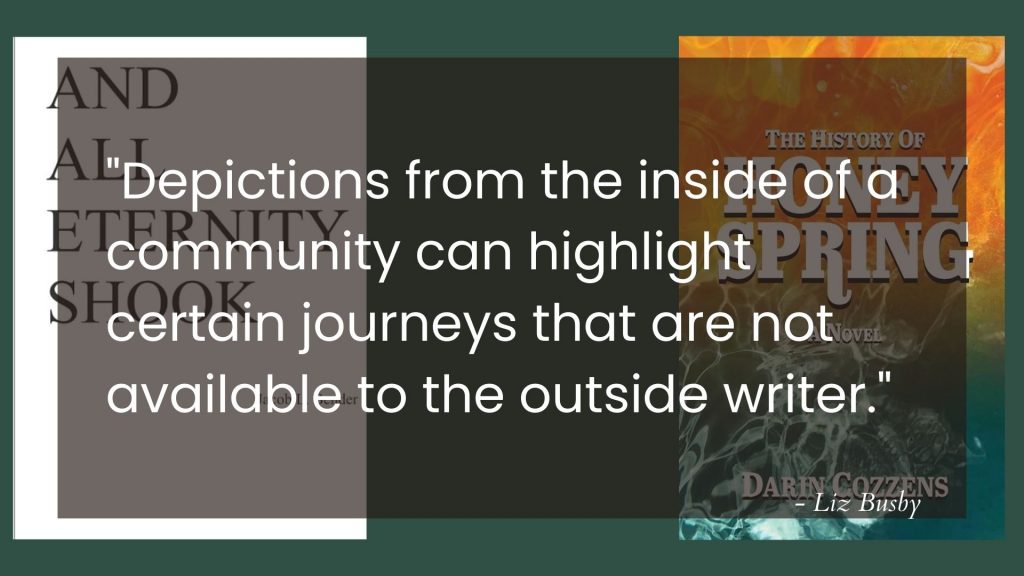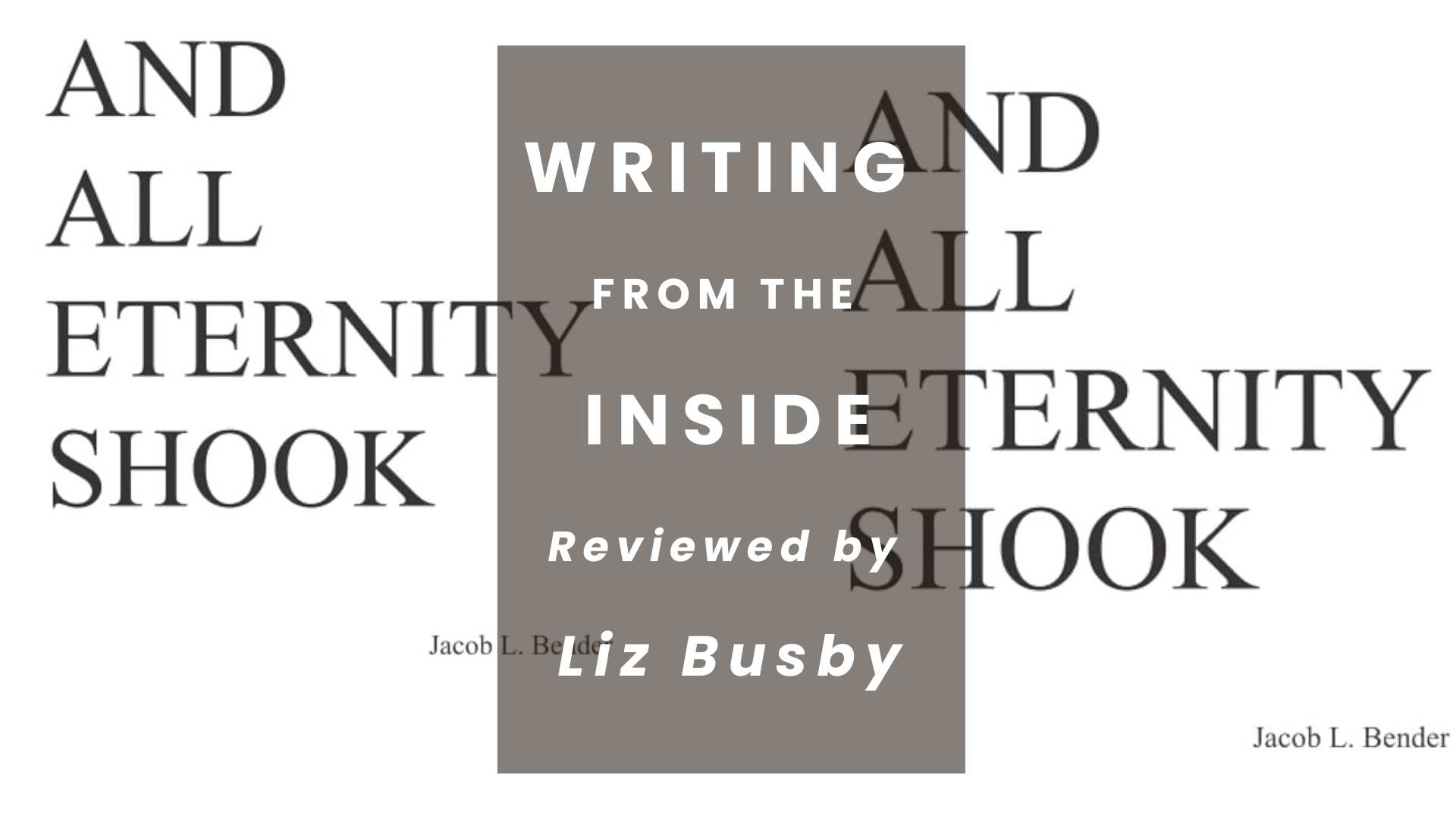Articles/Essays – Volume 57, No. 2
Writing from the Inside | Jacob Bender, And All Eternity Shook, and Darin Cozzens, The History of Honey Spring
Lately, I’ve heard in a couple of different places that faithful Latter-day Saints just can’t write perceptively about their community. Often, these assertions are offered as a justification for the recent proliferation of the Hollywood Mormon crime dramas that claim to portray the realities that Saints would like to cover up. Others use this idea to try to explain why the most well-known writers of Mormon literature are often those who are on the edge or have left the Church, such as Virginia Sorenson and Maureen Whipple. While an outsider’s perspective is no doubt of value, I object to the idea that it provides all the insight necessary to create a literary portrait of who Latter-day Saints are. Depictions from the inside of a community can highlight certain journeys that are not available to the outside writer, as the recent movement for “own voices” has established. Two recent novels provide excellent examples of the types of insightful fiction I believe can come from the insider perspective: And All Eternity Shook by Jacob Bender and The History of Honey Spring by Darin Cozzens.
At the surface level, these two books share one thing in common: their protagonists are Mormon young men returning to a changed home. And All Eternity Shook features Elder David Warner, a young missionary who returns from his mission to Puerto Rico to find that his family has disguised the severity of the recurrence of his mother’s cancer and that she is only days away from passing on. This character is a lightly fictionalized version of author Jacob Bender, who had a similar experience. (Indeed, the first-person nature of the narrative and its very interior focus mean this pseudonym is rarely used. In fact, I found myself several times startled by the appearance of “Elder Warner,” thinking that I’d missed a character for half of the book.) The protagonist in The History of Honey Spring, Jim Ray, faces not the death of a close family member, for he’s already an orphan, but an unexpected inheritance from a long-lost relative determined to keep his property out of the hands of spiteful neighbors. Jim has just returned home from the Vietnam War, and the comparative isolation of this distant cousin’s Colorado ranch offers him the opportunity to unwind some of the posttraumatic stress disorder from his war experiences and decide his own relationship to his untethered future.
From this similar beginning, the two books diverge widely in their approach to narrative and how to evoke an emotional response in the reader. Jacob Bender’s And All Eternity Shook is experimental in style, leaning heavily into a poetic style, as he interweaves narratives from different periods in Elder Warner’s life. For example, a chapter near the middle of the book flips between a childhood memory of his mother singing a lullaby, an imagined prayer walk with Jesus around the Santo Domingo temple grounds begging for his mother’s life, the story of his mother’s life retold as a biblical fable, and his stumblings as a naïve missionary trying to comfort a family who has lost their child. One can see from this list the sorts of connections the chapter draws, but it’s another thing to experience them like a fast-cut movie, flashing back and forth between times and realities until it all blends together. Though the reader may sometimes be unsure for paragraphs at a time exactly where they are in David Warner’s life, this style is mostly effective because the book is not so much concerned with plot as with the disorienting emotional roller coaster he is experiencing—his whiplash transition from dedicated missionary to grieving son. Bender doesn’t hold back any of his character’s thoughts from the reader, causing us to experience the buffetings along with him.
In The History of Honey Spring, Daren Cozzins takes the opposite approach both emotionally and stylistically. Like its late-1960’s protagonist, the narrative buries its emotions in descriptions of farm tasks and small-town digressions. As Jim Ray learns how to be a farmer and rancher from his lawyer, tenant, and now friend Nolan Rickett, we gradually learn more about the nature of the town where he has moved. The titular Honey Spring located on the property boundary is the source of a feud between Jim’s dead relative and the neighboring Vanderfisk family, who wants to turn it into a roadside attraction. The plot proceeds with the ripple effects this decades-long dispute, interspersed with humorous commentary on rural life, like how strangers driving along the highway will assume everything is public property and free for the taking unless Jim keeps his gate closed. One pivotal scene takes place when some neighbors are helping Jim castrate his calves, complete with a vivid description of the process, which the narrator somehow renders charming and even humorous. They discover that the Vanderfisk’s bull has wandered into Jim’s land despite their strict separation, the implications of which ring through the rest of the plot. Embedded in these long farming and ranching meditations are blink-and-you’ll-miss-it hints as to why Jim accepted the inheritance, flashes of his companions in Vietnam who weren’t so lucky as to make it home, and Jim’s ambivalence about the arbitrariness of his survival. I found the slow burn portrait compelling once I accepted it on its own terms, but readers who are used to being pulled along by a cliffhanger plot may struggle with Cozzen’s quieter structure.

The way The History of Honey Spring engages with Mormonism is similarly under the surface. Rather than wrestling directly with Latter-day Saint doctrines or history, the novel engages with Mormonism on the level of the community, using the literary tropes of small-town life to build a portrait of the small-town ward. Everyone in Balford, Wyoming, has known each other forever, long enough to be overly familiar with each other’s foibles. As a nonmember who has lived in the area for years, Jim’s lawyer Nolan Rickett declares the town the “mother lode of Latter-day Saint sanctimony,” but his attempts to detest his neighbors are “marred by this or that unbidden kindness, by compassion or generosity, by some genuine goodness associated with the faith” (129). Cozzens gives us the awkward bishop interview about any sexual sins that may have happened while Jim was in the military, but he also gives us the scene when long-suffering members of the elders quorum show up to help with cattle branding “in response to an invitation made just yesterday in priesthood” (130). We get ward softball games, underattended singles activities, and ward gossip about Jocelyn Vanderfisk, the niece of Jim’s neighbors visiting from Bear Lake. Jim is attracted to her but unsure about whether approaching her will make the feud over the spring better or worse. It’s difficult to capture the feeling of a longstanding ward without straying into either caricature or sentimentalism, but Cozzens manages to create a cast of characters that feels both archetypal and yet specific. In the end, the town’s issues begin to unravel not with a confrontation or drama, but with the promise of a date while putting away chairs after a funeral, the most Latter-day Saint “meet-cute” that I’ve ever seen in print.
On the other hand, Bender takes a more head-on approach in engaging with LDS theology and culture in And All Eternity Shook. Bender said in promotional material that he believes that the experience of losing a loved one while on a mission is a fairly common experience that he hadn’t found represented in our literature. I can testify that my husband’s experience of nearly losing his mother to a stroke while serving in Japan was a perspective-altering event for him. Much of the novel is spent condemning the way our culture shies away from the negative emotions brought up by difficult experiences. Warner condemns the way we have read the Book of Mormon as a “sacral coffee-table collection” rather than as a deeply tragic record of the downfall of a people (48). Like the biblical Jacob, Elder Warner wrestles with God over the unfairness of not receiving a miracle in exchange for his missionary faithfulness. In the climactic scene of the novel, he pulls no punches as he outright threatens God in a rage of grief and desperation: “I will pipe bomb the Temples, burn the scriptures and set the chapels ablaze. I will pursue and persecute the Saints as did Saul of Tarsus, and there will be no vision on the road to Damascus to stop me. I will kick against the pricks until the pricks are destroyed and we are all finally free” (108). Though it’s possible to read these extremes of emotion as over the top, the earnest youth of Elder Warner carries through Bender’s message: that only a faith that has gone through not only extreme melancholy but extreme rage can then become strong and unshakeable. The resolution to this journey occurs only in the last sentences of the story, but the reader, having been through it all with Elder Warner—and with Bender—will experience it as something profound, like the exhaustion at the end of a well-run race.
Both books are part of well-established genres, though ones of opposite nature. Bender’s fictionalized autobiography will appeal to readers of poetry and literary fiction—those who are open to a raw and personal wrestle with God. This novel presents no sugar-sweet doctrine of “everything happens for a reason,” yet its faithful conclusion will bring comfort to many who have likewise suffered with unresolvable trials. Cozzen’s western, small-town tropes will appeal to a completely different set of readers, those who love Wendell Berry and Wallace Stegner. Perhaps even those non-Latter-day Saints who live among the Mormon-oversaturated communities of the Jello Belt may find their neighbors faithfully portrayed in this novel. Both books, though, prove the point that Latter-day Saints can write complex fiction about their own experiences and communities.
Jacob Bender. And All Eternity Shook. Ships of Hagoth, 2022. 130 pp. Paper: $15.99. ISBN: 979-8210209306.
Darin Cozzens. The History of Honey Spring. Zarahemla Press, 2022. 296 pp. Paper: $14.95. ISBN: 978-0999347263.


 Back to full Issue
Back to full Issue

